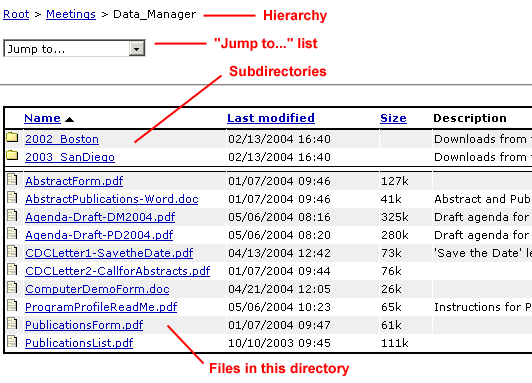
The files available in the Files and CDC Files tabs are organized in multiple levels of directories. The names of each file and subdirectory in the directory you are currently viewing are listed in a table. (When you first access either section, its root, or topmost, directory will be displayed.) Subdirectories are marked with a folder icon, and are listed first. Files are marked with a document icon, and are listed following the directories, after a small separating space.

Find the files you want using the following navigation tools:
At the top of the page is a list of directory names indicating your current position in the hierarchy. The rightmost name listed is the name of the directory you are currently viewing. The names to its left are higher-level directories, and you can click on their names to view them. In the above example, the user is viewing the Data_Manager directory, which is a subdirectory of the Meetings directory, which itself is a subdirectory of the root directory.
The Jump to... drop-down list under the hierarchy listing provides quick access to the immediate subdirectories of the root directory. Select any directory name in this list to view its contents.
If there are any subdirectories in the current directory, they will be listed at the top of the table. Click on the name of a subdirectory to view its contents.
If there are any files in the current directory, they will be listed below the subdirectories. Click on the name of a file to view it. Depending on the type of file and your browser settings, you may be able to view the file directly in your browser window, or it may open automatically in a separate application. However, you may have to save some types of file your hard drive or local network before you can open them (see instructions below).
To make it easier to find files or subdirectories, you can click the headers of some columns to sort the table according to the contents of those columns. Click the link once to sort the rows according to that column, and click it again to reverse the order of the sort. An arrow next to the column header indicates which column the table is sorted by, and whether the sort order is ascending (up) or descending (down). For example:
If you click the Size link, the files will be arranged in order from smallest to largest. If you click it again, the will be arranged in order from largest to smallest.
Any file can be saved to your hard disk or local network. The method for saving will vary depending on your browser and operating system. Right-click or Control+click on the filename to see a pop-up menu. Find the menu item that saves the file: its name may be Save Link Target As... or something similar. Click the menu item, then navigate to the directory in which you want to save the file, and click Save.